Perhaps the most prominent characteristic of the Bengal cat is it’s beautiful coat; having a mini leopard in your home is a real exotic experience. But what most people don’t know is that there is more than one color and pattern that a Bengal cat can come in, from the standard Brown Spotted to the rarer Silver Marbled. Bengal cats are truly a unique breed because almost no other cat breed has such interesting and distinct color and pattern categories. In this guide we’ll go over the many interesting Bengal cat colors and patterns.
Breed Accepted Colors and Patterns
Bengals have only three accepted colors and two accepted patterns that they can come in, as outlined in the table of contents below. Click each link to view more about that particular color or pattern:
Patterns
Colors
Bengal Cat Patterns
Spotted Pattern
The spotted pattern is the most common pattern in the Bengal cat. Odds are most of the Bengal cats you’ve seen in real life or photos are of the spotted pattern.
There are different types of spotted pattern, but one of the most common and most prized is the large, random two-toned rosetted markings. This is the spotted form that makes Bengal cats look most like mini leopards.
Single Spotted vs. Rosetted

Spotted pattern Bengals can either be single spotted (just monochrome, solid spots splattered on the contrasting background) or rosetted (two-toned spots of contrasting colors on a background color). As mentioned before, the rosetted Bengal tends to be more popular. Even more interestingly, Bengal cats are the only domesticated house cats with a rosetted pattern!
Bengals are a fairly recent breed to begin with, but the rosetted pattern only just emerged in the early 2000s from breeders specifically targeting the two-tone trait.
Types of Rosettes
As if the spotted pattern couldn’t get any more specific, the rosette spotted pattern is further broken down into six different types! Those types are:
- Arrowhead rosettes – These markings are shaped in a triangular form, with the tips of the triangles pointing towards the back. This pattern is referred to as arrowhead due to the patterns looking like the tips of arrows. One of the biggest differentiators between the classic tabby’s coat and the Bengal cat’s coat is that the tabby’s patterns run vertically, while the Bengal’s runs horizontally. The arrowhead pattern on the Bengal further emphasizes this horizontal pattern.
- Donut rosettes – This pattern is defined by the spots being darker than the background coat color, and more specifically the ring (or outline) around the spot being the darkest.
- Paw-print rosettes – These spots are distinguished by never being fully enclosed by an outline around the spot. One side of the spot is left open, while the other is outlined by dark spots, making the spot look very much like a paw-prints.
- Clouded rosettes – These rosettes have spotted markings that are fitted very close together will little space between to show the background color of the coat. This pattern is oftentimes likened to the pattern on a snake.
- Chain rosettes – As the name suggests, the chain rosette pattern consists of a bunch of donut spots linked together horizontally running down either side of the Bengal’s spine.
- Cluster rosettes – As opposed to having a thick, distinct outline around the spot, the cluster pattern is a cluster of spots surrounding the main spot. The main difference between a cluster and paw-print pattern is that the cluster dots surround the spot in the cluster pattern, and the dots are crowded to one side on the paw-print pattern, leaving the there side open.
Marbled Pattern
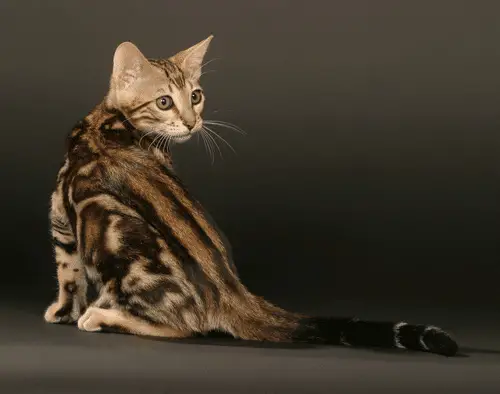
The other main Bengal cat pattern is the marbled pattern, which is comprised of blotched tabby stripes that swirl. There are four types of marbled pattern, which includes:
- Reduced Horizontal Flow
- Horizontal Flow
- Chaos Pattern
- Sheet Marble Patterns
The ideal marble pattern on a Bengal is considered to be a horizontally flowing, random, asymmetrical pattern made up of swirls of two or more colors.
The first marbled pattern was produced seemingly by accident in 1987 by Jean Mill of the Millwood Cattery. Jean had not intended to breed any pattern except for standard spotted, but his marbled litter gained instant traction at competition, and the marbled category was born.
It’s from this marbled pattern the rosette pattern arose in the early 2000s.
Sparbled Pattern
While the sparkled pattern isn’t officially recognized by breeding standards for the Bengal cat, it’s nonetheless a beautiful and enchanting pattern that combines the spotted and marbled patterns.
Bengal Cat Colors
There are only six colors that a Bengal cat can come in, three standard (recognized by The International Cat Association) and three nonstandard. Although it seems like simple categorization, combining the Bengal cat’s patterns with these six different colors creates an endless variety of looks.
The three standard colors are:
The three nonstandard colors are:
Brown Color
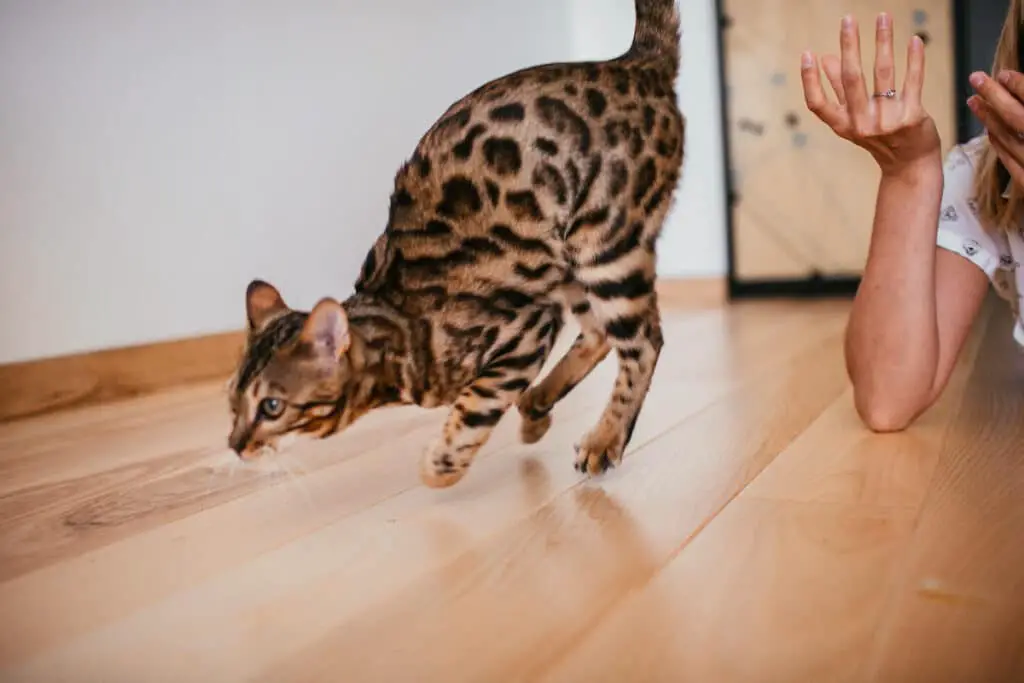
The brown Bengal cat is the most popular of the Bengal colors; it’s the most quickly recognized one that’ve probably seen a million times. The brown Bengal usually has green or yellow eyes and can come in a wide variety of brown shades.
Snow Color
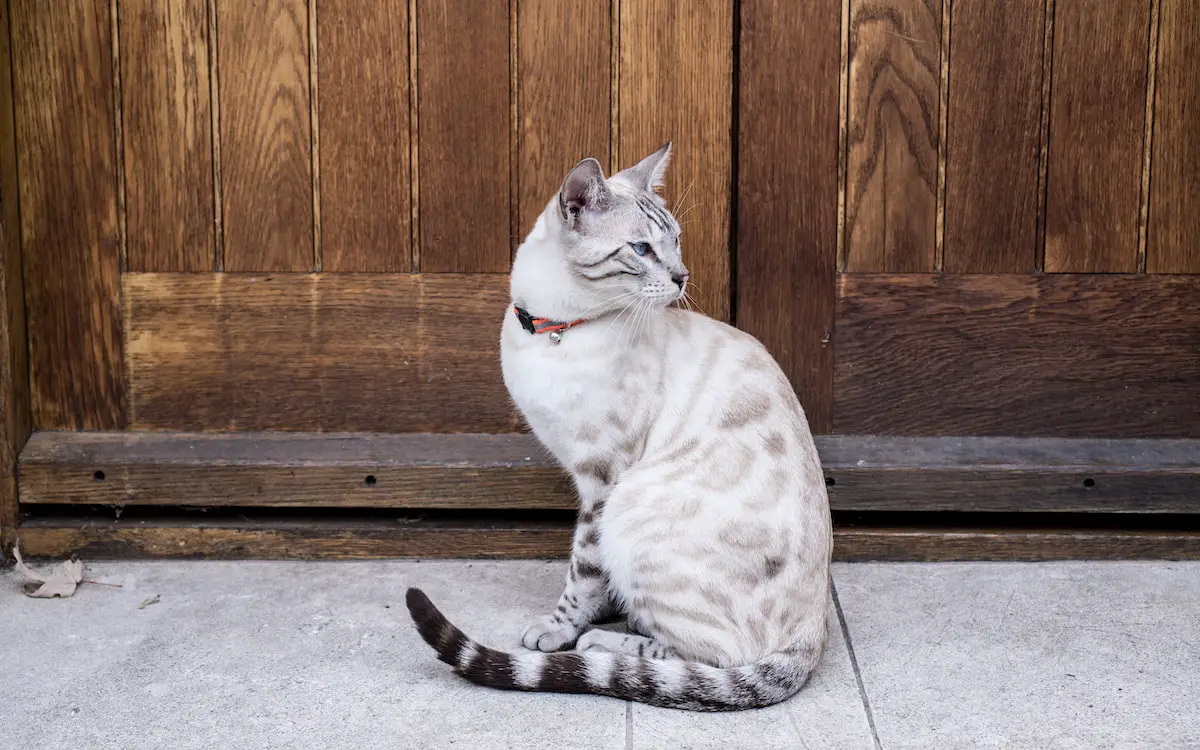
The snow Bengal looks like an adorable mini snow leopard, and gets its white color from albino genes from cross-breeding with Siamese and Burmese cats.
The snow Bengal isn’t completely white, and comes in three different varieties:
- Seal Lynx – This snow color Bengal always has blue eyes and is a very light cream color with seal colored markings and a dark tail tip.
- Seal Mink – The seal mink is more of a light tan color with dark seal markings and blue or green eyes.
- Seal Sepia – The seal sepia is a light tan color with seal sepia to dark seal sepia colored markings. Its eyes are green or yellow.
Silver Color
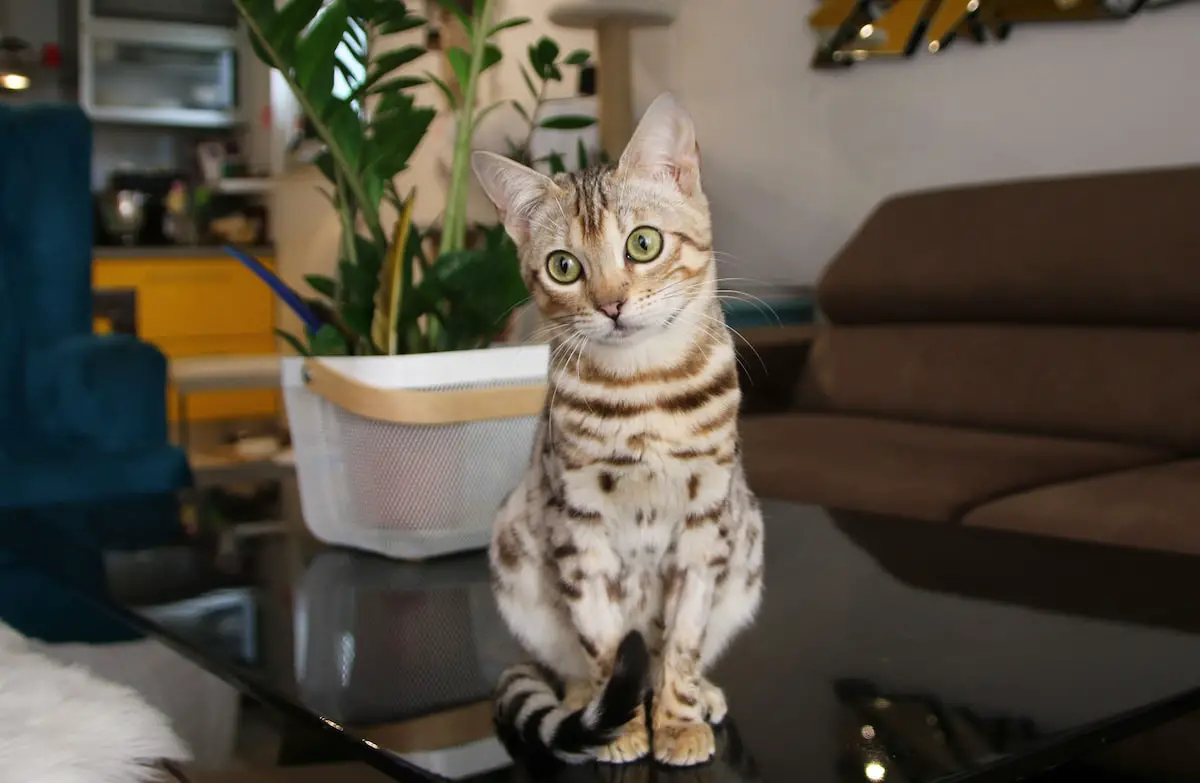
The silver Bengal was only upgraded to competition level by TICA in 2004, making it one of the more recent varieties of Bengal.
The Silver Bengal is marked by having a more white base of color, eliminating almost all the warm colors.
Charcoal Color
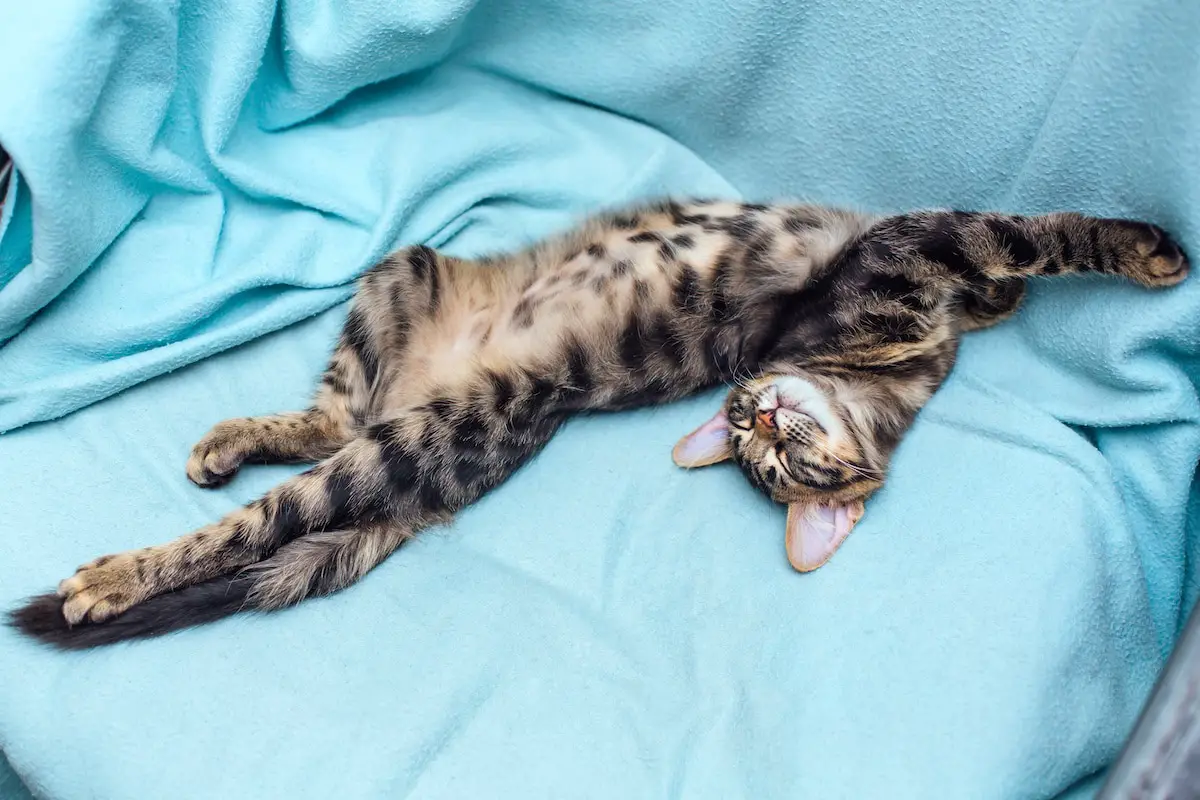
As an unrecognized color by TICA, the charcoal Bengal is a darker shade than the traditional Bengal colors. It can result in a dark grey or brown color and a very dark spotted or marbled pattern.
Charcoals also typically have a darker face mask and a thick stripe going down the back of their spine, commonly referred to as the Zorro cape and mask.
Blue Color
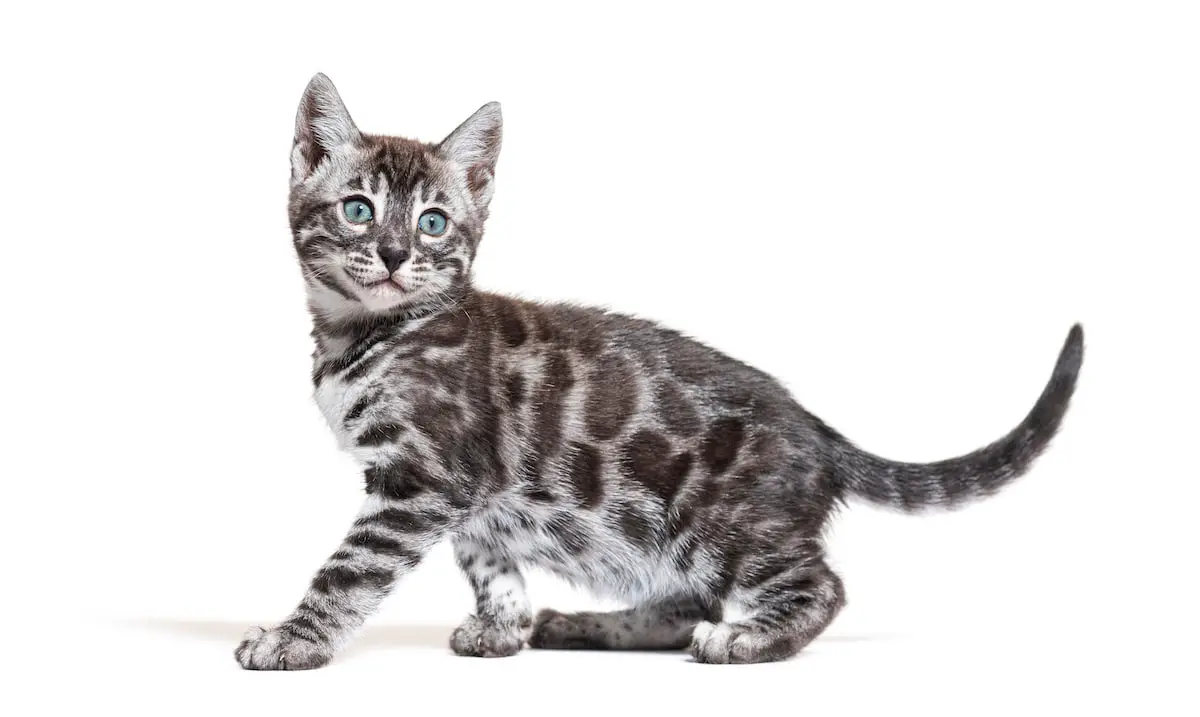
The blue color in blue Bengals is a recessive trait, so it must be passed on by both Bengal parents. This color is marked by a more powder blue/grey coat with some cream. Blue color is one of the more rare colors within the Bengal cat colors and patterns guide.
Melanistic (Black) Color

These Bengals are almost solid black, resembling a jaguar. In fact, melanism is the opposite of albinism, causing more pigmentation than is typical in the skin of an animal.
The spots on these Bengals are really hard to see due to the dark color, but they’re there, and can often be seen in bright sunlight. Because they’re so hard to see, they’re often referred to as “ghost markings”.
Glittering
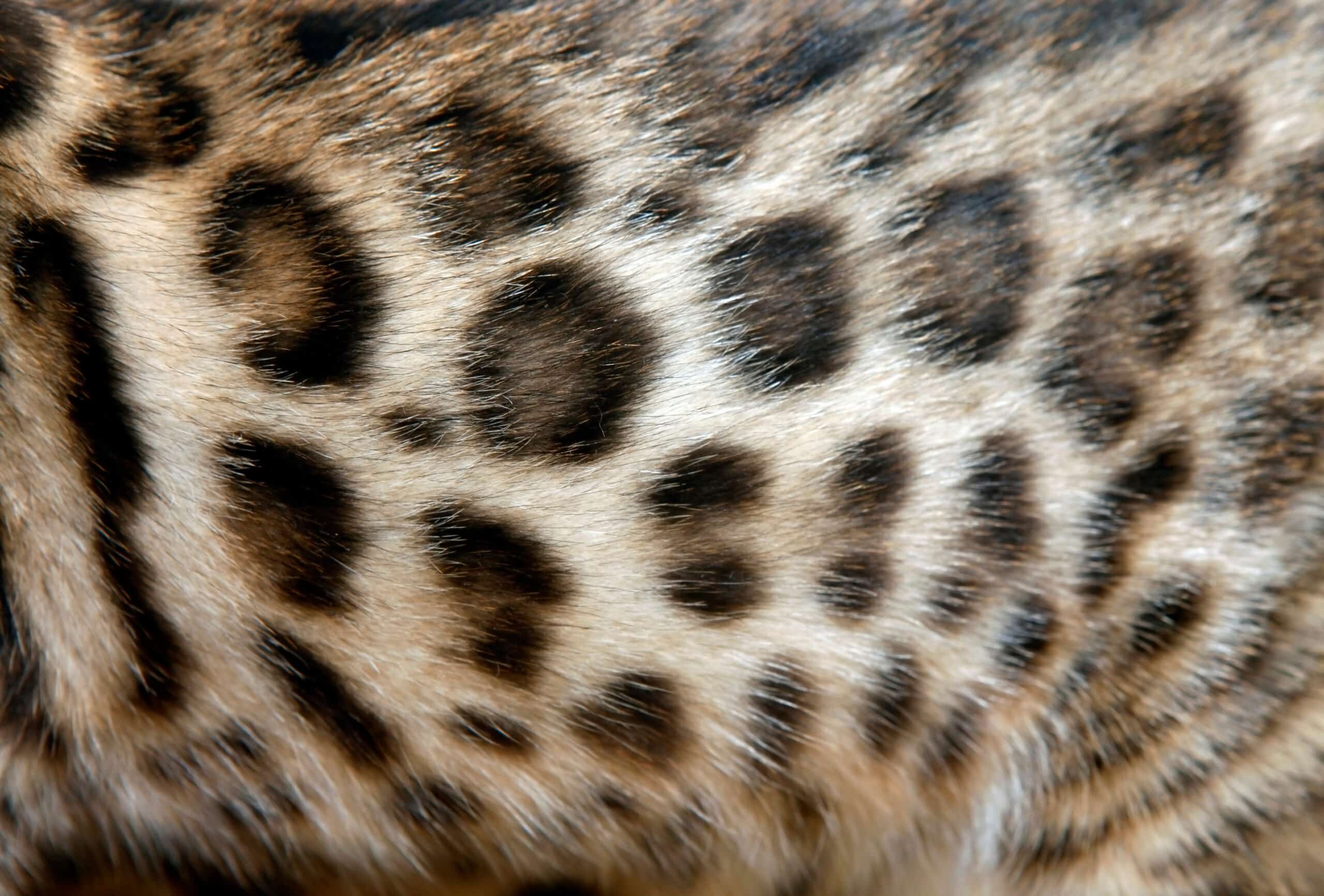
And as if Bengals couldn’t get any cooler, some have the appearance of glitter on their coat! This is caused by translucent hollow hair shafts that catch light and reflect it, giving the coat a glittering look in the sunlight.
You can read more into the Bengal cat colors and patterns in the CFA guide.
FAQs
The most common Bengal cat colors are brown, silver, and snow. Brown Bengals are the classic color choice and come in a range of shades from light taupe to dark chocolate. Silver Bengals have a distinct smokey grey color that almost looks like a sheen. Lastly, Snow Bengals have a white coat with bold black rosettes and spots, making them the most eye-catching of the bunch.
The Brown Rosetted pattern is the most recognizable and popular Bengal cat pattern. This pattern consists of brown spots, usually in a circular pattern, that cover the cat’s body. The background colour of the cat is usually a light beige or ivory colour. The spots may range from small to large, but they must be distinct and clearly defined.
The Marbled pattern is also popular among Bengal cats. This pattern is created when the rosettes mix together to create a swirling, marble-like pattern. The background colour of the cat is usually a light beige or ivory colour, while the pattern is usually brown or grey.
The rarest colors in Bengal cats are blue, charcoal, and melanistic. Blue Bengals are a light, silvery grey with a hint of blue. Charcoal Bengals are a deep, dark grey with a hint of silver. Lastly, melanistic Bengals have a black coat with bold spots and rosettes.
The Snow Spotted pattern is the least common of the three patterns. This pattern consists of white spots on a light grey background. The spots are usually quite small and have a distinct shape, such as a paw print or a star.
The short answer is no: Bengal cat colors and patterns are purely aesthetic and do not affect personality. That said, some Bengal cats may appear more confident or outgoing due to their markings. This is likely because the bolder, brighter patterns of a Bengal cat can make them stand out more, which can give them a sense of pride and confidence.
However, it’s important to note that all cats, regardless of breed or color, have their own unique personalities. While some might be more outgoing or confident, others may be more shy or reserved. It’s important to take the time to get to know your Bengal cat to understand their individual personality and temperament.
It’s also important to remember that Bengal cats can come in a variety of different colors and patterns, from traditional brown spotted to the bolder, brighter snow leopard-like patterns. Each color and pattern can be equally beautiful and make your Bengal cat unique.














